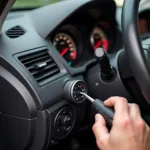Imagine this: You press the gas pedal, but your car reacts as if it’s still waking up. That’s exactly what pedal tuning addresses! It’s not about directly increasing engine power, but about optimizing the response time of the accelerator pedal. Instead of that sluggish feeling when accelerating, your car responds more directly and eagerly. Sounds promising, right?
 Diagram showing how pedal tuning improves car's throttle response
Diagram showing how pedal tuning improves car's throttle response
How Does Pedal Tuning Work Its Magic?
Basically, pedal tuning modifies the electronic connection between your gas pedal and the throttle valve. Modern cars use an electronic gas pedal that sends signals to the engine control unit. Pedal tuning alters these signals so that the throttle valve opens faster and more aggressively, even with slight movements of the gas pedal.
“You can think of it as a turbo for throttle response,” explains Dr. Ing. Markus Schmidt, an expert in vehicle electronics. “This makes the car feel significantly more responsive and dynamic, especially in the lower RPM range.”
Benefits of Pedal Tuning:
- Improved Responsiveness: Your car reacts faster to gas pedal commands.
- Increased Driving Fun: Especially when starting off and overtaking, the more direct throttle response provides a more dynamic driving experience.
- Reduced Turbo Lag: In turbocharged engines, pedal tuning can help reduce turbo lag and ensure faster build-up of boost pressure.
Is Pedal Tuning Right for Me?
Whether pedal tuning makes sense depends on your individual needs and driving style. If you are looking for a way to improve your car’s throttle response and make the driving experience more dynamic, pedal tuning could be the right solution.
Important: Pedal tuning is not the same as chiptuning! While chiptuning directly increases engine power, pedal tuning only optimizes throttle response.
Pedal Tuning vs. Chiptuning: What’s the Difference?
Many car drivers confuse pedal tuning with chiptuning. However, the difference is clear:
- Pedal Tuning: Optimizes throttle response and engine responsiveness.
- Chiptuning: Increases engine power and torque.
What Should I Look For in Pedal Tuning?
- High-Quality Tuning Module: Make sure you choose a high-quality pedal tuning module from a reputable manufacturer. A cheap module can lead to malfunctions and damage to the vehicle.
- Professional Installation: Have the pedal tuning installed by a professional workshop.
- Test Drive: After installation, you should definitely take a test drive to get used to the changed throttle response.
Conclusion: Pedal Tuning – A Small Step for Your Car, a Big Step for Your Driving Pleasure!
Pedal tuning offers a cost-effective way to improve your car’s throttle response and increase driving fun. If you are dissatisfied with the sluggish response of your car, pedal tuning might be the right solution for you.
Do you have questions about pedal tuning or are you interested in other ways to optimize your car? Contact us! Our automotive experts will be happy to advise you and help you get the best out of your vehicle.

